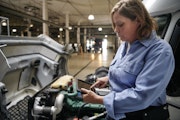5 ways to focus on safety with GPS fleet tracking
For businesses that rely on vehicles and drivers to keep things running, safety is everything. Learn how GPS tracking...
Read more
Hard braking and hard acceleration negatively impact both fleet safety and fuel consumption. That’s why it’s essential for fleet managers to monitor these driving behaviors as part of any comprehensive fleet driver safety and training program. Doing so can help companies save money and help mitigate accidents or injuries.
Harsh driving can be broadly described as any sudden change in direction or velocity of a vehicle or truck moving at a steady rate. It is often characterized by abrupt changes in g-forces, which can be monitored using accelerometers. Rapid increases in speed, sudden braking and cornering at a high speed are all examples of harsh driving and indicate unsafe or aggressive driving habits.
Hard acceleration or braking occur when a driver applies more force than necessary to the vehicle's accelerator or brake system. This behavior is sometimes referred to as 'lead foot' syndrome, and it can be an indicator of aggressive or unsafe driving behavior. It is also contributing to fuel waste.
Hard braking and acceleration events can alternatively indicate crash avoidance, or that a driver has been involved in an accident. Some vehicle GPS tracking systems use ACN (Automatic Crash Notification) to automatically contact emergency services if very hard braking (or deceleration) occurs. It should not be presumed then that hard braking or acceleration is always an indicator of unsafe driving.
The detection of sudden acceleration and harsh braking events is made possible by accelerometers, which are now commonly included in most GPS devices. These accelerometers measure movement and its intensity in a specific direction. A piezoelectric accelerometer, which uses a suspended mass inside a fixed container, is one of the most common. As the container is moved, the mass moves in the opposite direction, putting pressure on the quartz crystal, which in turn converts that pressure into an electric signal. The greater the force, the greater the electrical current.
Depending on how it is being used, an accelerometer has different levels of sensitivity, suited to its application, whether in a smartphone or inside a motor vehicle. The electrical current it generates is used to trigger a report that can be interpreted by telematics software, as well as real-time alerts to the driver.
Harsh braking and acceleration can increase the risk of accident or injury to fleet drivers and others sharing the road. Consistent hard braking may indicate the driver is following traffic too closely, increasing the chances of rear-end collisions and injury to those involved. It can also lead to dangerous situations, such as fleet trucks 'jackknifing,' resulting in potentially severe incidents.
Additionally excessive hard braking and acceleration can cause vehicle brakes to overheat, damaging the metal components or glazing brake pads. This makes them less effective and reduces their lifespan, ultimately putting the driver in danger of not being able to stop when needed. Hard braking can also trigger a vehicle's Anti-lock Braking System (ABS) unnecessarily, putting extra stress on the system and increasing wear and tear on vital components.
Safety is an investment that should never be undervalued. It’s not just part of a company's responsibility to its staff, but also part of its corporate responsibility to the general public. Advancements in technology now make it economical and easy for fleet managers to detect unsafe driver behaviors, effectively coach drivers and implement safety programs around safe driving standards.
Download this free infographic to learn 3 ways dashcams boost driver safety.
While harsh driving affects fleet safety, it also impacts a company’s bottom line. Speeding on the highway can reduce fuel economy by as much as 33 percent, according to the Department of Energy. If hard braking is related to speeding, whether on the highway or neighborhood roads, it directly impacts fuel costs and fuel waste.1
Taking corners too quickly also impacts costs. If a driver is transporting goods or equipment, they might be jostled in the turn and damaged, and replacing them is a cost that comes out of the company’s pocket. Getting to a job faster by putting the pedal to the metal can cost the business more in the long run.
GPS vehicle tracking gives you a clear view of the driving styles of all employees—whether they are meeting and exceeding safety expectations or need coaching to remind them to slow down. Fleet managers can help their drivers become more conscientious of their driving using video-based coaching that promotes transparency with uploaded dashcam videos. By showing drivers videos of harsh driving events, drivers can be given the right information so they can adjust and correct behaviors.
These systems monitor speed, idle times, harsh braking and fuel usage across all vehicles and all drivers, giving managers actionable data to help employees improve. Managers can run reports on each individual vehicle or each driver or calculate fuel cost for the whole fleet in a month, or how much fuel one driver uses versus another for the same number of miles driven.
Want to hear how using fleet tracking technology can help you prioritize safety across your fleet? Schedule a demo with one of our experts.
1https://www.fueleconomy.gov/feg/driveHabits.jsp
Tags: Cost control, Performance & Coaching, Safety, Team Management, Training, Vehicle Maintenance, Data & Analytics




Find out how our platform gives you the visibility you need to get more done.
For businesses that rely on vehicles and drivers to keep things running, safety is everything. Learn how GPS tracking...
Read moreLearn how innovations in video powered by AI and machine learning are helping to reshape safety and efficiency for businesses.
Read more7 Secrets to a Safe Fleet
Read moreLearn how AI-powered dashcams and extended view cameras improve driver safety, provide real-time coaching, and reduce...
Read more